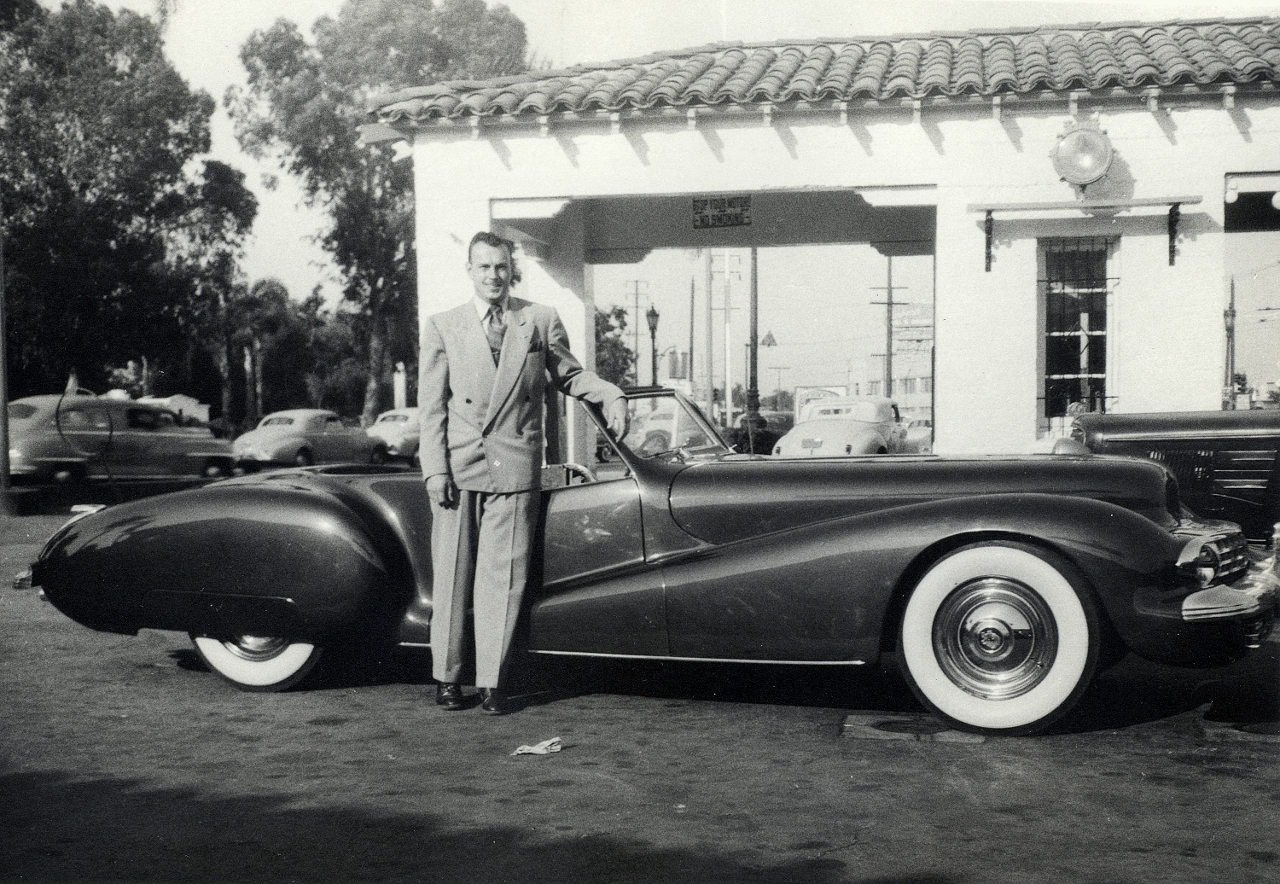
Note: Today’s guest post is by a friend of mine, April Chadwick. In addition to being into cars as much as I am, she also owns an Excalibur Series 1 and 1976 Continental Mark IV. Please give her a warm welcome! -TK
If you are reading this site, you have likely owned your fair share of vehicles and I am sure that there is at least one that you wish you still had. The one car that you let slip through your fingers because of timing, finances or practicality. It’s often these considerations that conspire to separate us from our automotive one true love.
Phil Lacey, Sr. knows that feeling, perhaps even more than any of us. I am not talking about some jacked up Camaro or a Honda with aftermarket rims. Over half a century ago Phil helped design and build his own dream car. A true labor of love, he never saw his garage built custom (notice I didn’t spell it with a k) completed or even knew if it still existed.
The Car:
The Fitzpatrick occupies a unique place in N. American automotive history, it is along with few other examples the missing link between coach built cars of the thirties and customs of the fifties.
The Fitzpatrick’s genesis is in those coach built cars of the pre-war rich and famous, while it’s private construction has more in common with the Kustom Kulture of the fifties.
The Fitzpatrick name comes from the original owner and patron of the car, Al Fitzpatrick. However, the cars true father is Phil Lacey, whose remarkable sketches inspired Al to bankroll the cars construction.
The Fitzpatrick body was created over a three-year period by Phil and a body man assistant known only as Lucky. In past articles the body work is mistakenly but understandably credited to the Fitzpatrick custom shop, no wonder no one has found any information on this previously unheard of torch wielder. A situation made even more confusing by the plaque under the hood that read: Manufactured by; Fitzpatrick Custom 109 So. Kingsley Dr. Los Angeles, Calif.
The design of car is remarkably close to Phil’s original sketches. The Fitzpatrick went from drawing board to reality with no middle-manager bean counters to mess up the design. Fresh from his experience as a fighter pilot in WWII, Phil was underwhelmed by what passed for new postwar cars. Why were they so high and boxy, perched on top of the frame with so much space above the engine?
In no time he had put pencil to paper and created a series of sketches that revealed a long, low and powerful looking roadster. Phil, it should be noted, was not a trained draftsmen or automotive designer, however his portfolio of sketches for what would become the Fitzpatrick looks as if it could have been pinned on the wall of any big three design studio.
Only one of his professional looking renderings had the graceful fade away fenders seen on the finished car. In retrospect Phil Sr. said if he knew how much trouble those swoopy fenders were to make he never would have done it.
The beautiful sweeping fenders were created entirely by hand, fabricated out of small hammer welded pieces of steel, without the benefit of lead filler. Approximately one hundred pieces were needed to make each fender. The individual pieces were cut then heated up with an oxy–acetylene welder then hammer formed into shape and welded into place. Lucky would form eight or ten pieces at a time then start the process all over again.
This method of building complex body shapes is not unheard, famous customizer Daryl Starbird continues to use a similar method to build his bubble topped creations to this day. Phil Sr. was not just the designer he worked closely with Lucky getting his hands dirty actively involved in every step of the build. In his own words it was three years of sweat, blood and tears, working every evening in a single car garage.
The styling of the Fitzpatrick is a modern interpretation of classic thirties luxury roadster. The fade away fenders and swallowtail doors are the height of contemporary style with ultra modern elements such as the horizontal grill adapted from a Lincoln Continental and vestigial finned taillights courtesy of a 46 Cadillac. The overall height of the Fitzpatrick is only 48 inches, production cars would not get that low until the Corvette Stingray. To quote the Fitzpatrick’s only contemporary publicity in a November 1950 Road & Track article, the customs height was, “exactly level with the top of a 1950 Buick hood”.
The doors and hood were constructed using aircraft grade steel tubing then wrapped in sheet metal. The after mentioned cut down doors are reminiscent of a Packard Darrin but as Mr. Lacey is quick to point out he included this design feature purely to aid the driver in assuming that classic cruising stance. Elbow of your left arm resting on the top of the door while you steer nonchalantly with your right hand. The size of the hood meant this is the one area where the guys sought professional help, having a company in downtown LA shape the metal over the hoods tube frame.
The quality of the body work rivals that of professional coach builders and has held up beautifully over the years and miles. What is more amazing is the seemingly perfect symmetry of the complex fenders that so impressed the restoration and fabrication experts at Legendary Motorcar.
The highly stylized body envelopes a 1940 Packard 160 sedan frame and drivetrain. In order to get the car so low the body is channeled over the frame, a practice that would become common in the world of hot rods and kustoms. The cross member was removed from the Packard frame to allow the passengers to sit as low as possible inside the car, this also meant re-bracing the side rails and chassis to preserve its strength. A late model Buick donated its firewall and windshield while an oil well casing served as the center backbone.
The straight eight Packard mill was treated to some vintage speed equipment to raise the horsepower to a respectable 200hp. The intake manifold was actually custom made by race legend Frank Curtis. Returning to that 1950 issue of Road & Track the carburetion, ignition and compression ratio were modified to provide the 40 more than stock hp.
The Fitzpatrick has a removable Carson style top, popular in California, where it seldom rains. These removable hardtops had a look of a padded convertible top and were popularized by their namesake Amos Carson of the Carson Top Shop in LA.
Today the car features a formal black paint job and sedate red leather interior. In 1950 the color was a royal blue metal flake lacquer with a white tufted leather interior.
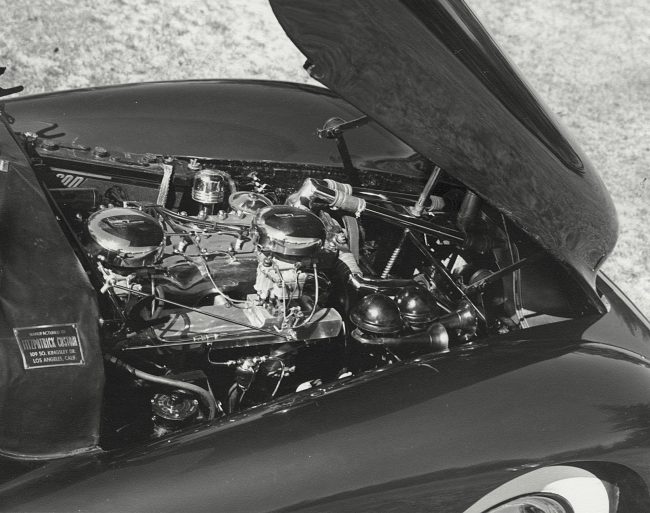
Coach Built vs. Kustom
At the end of the war there was a pent up demand for new cars. All Detroit could offer the general public was warmed over 1942 models for the next couple of years while they switched back to civilian production. The public however was anxious to get their hands on the futuristic dream cars that they had read about during the dark days of fuel rationing.
The desire for the future and the stodgy offerings in the showroom (Detroit would rise to the occasion and by the late fifties exceed the average motorists wildest fantasies) combined with the American can do spirit lead many to build their own automotive dream cars. The custom car movement in southern California and its sister trend the hot rod actually predated the war but didn’t really get rolling until car obsessed GI’s retuned home with money and ideas and started where they had left off.
The custom had yet to become kustom with a K, cars were modified to be more pleasing to the eye and not change for changes sake. It was not until a decade later in the mid fifties when car culture and the ensuing teenage demographic merged to give us the flamed, chromed and candy colored hot rods and customs we typically associate with the era.
These late forties and early fifties customs were elegant creations more in the spirit of the coach builders of the thirties. In fact a few of the remaining coach builders like Coachcraft and Maurice Schwartz of Pasadena continued to build one off cars in the same style as backyard or amateur customizers. These were cars designed to look equally at home at the country club or the drive in. The Nov 1950 Road & Track that included the story of the Fitzpatrick had a 1948 Cadillac styled by Saoutchik, a Parisian coachbuilder on its front cover. Interestingly enough another car filmed for Dream Car Garage television show.
The early custom cars were taken seriously and featured in traditional buff magazines as legitimate designs on par with factory prototypes. As it is today the automotive culture in southern California was extremely influential and the ideas expressed in these one off machines began influencing designers in Detroit.
In 1953 GM, the undisputed design leader offered perhaps the greatest compliment to Phil and his fellow customizers. At that years Motorama GM offered the public, at considerable expense, a trio of virtually hand made custom cars, the Buick Skylark, Oldsmobile Fiesta and the Cadillac Eldorado. Based on standard production models these dream cars featured almost as much lead work as if they had come from some California coach builder.
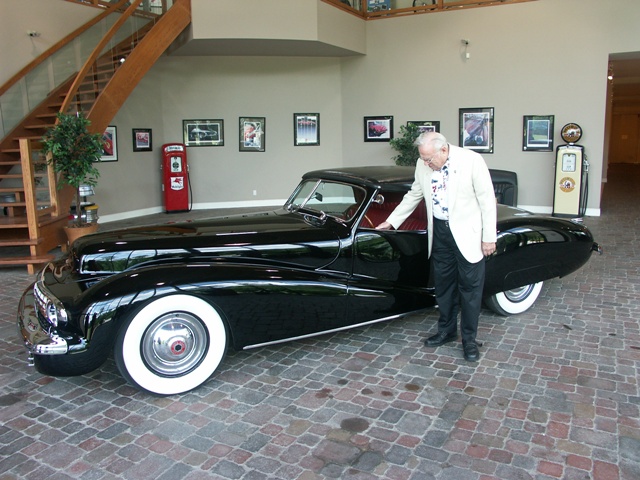
The Reunion:
Over the last ten seasons Dream Car Garage has featured some fascinating stories but perhaps the most compelling was the Fitzpatrick and the reunion of its designer and builder with his completed vision, after five decades.
Spurred on by concept car collector Joe Bortz, the idea for a reunion quickly took shape. Contact was made with Mr. Lacey’s son who had originally tracked down his father’s long lost custom to the Bortz Collection in Chicago. A true coincidence as Joe had been searching high and low for any additional information on his latest dream car acquisition.
Joe had seen the Fitzpatrick as a young man in Chicago and when the car came up for sale at auction in 2004 he was quick to add the mysterious roadster to his collection.
In the ensuing years the Fitzpatrick had found its way to Chicago and was owned in turn by Dave Levin and Frank Costello. The car was displayed at some hot rod shows in the early sixties before settling into long term ownership with a Pennsylvania enthusiast. Our Quaker State owner actually used the car for long distance road trips, which lead to the replacement of the Packard mill with a 350 Chevy, automatic transmission and air conditioning.
The reunion would be the kick off for our 2006 season of Dream Car Garage, the Lacys, son, father and spouses were flown in from California. It was a short trip from the airport to Legendary Motorcar where we would also meet up with Joe Bortz who had flown in from Chicago that morning.
In preparation the two story foyer at the Legendary facility had been cleared of muscle cars and exotics and in the center a long low shape lay disguised under an extra large car cover. The Fitzpatrick had arrived the night before and was quickly sequestered.
Tuesday morning the cameras were waiting as Phil Lacy Sr. watched the cover removed to reveal the custom creation he had not seen for half a century. Before the interviews and a test drive with Peter, he gently ran his fingers along the sensual flowing fenders and reminisced about the hard work and sacrifice it took to create such a thing of beauty.
We have filmed a lot of cars over the years and met many justifiably proud owners but if I had to pick a favorite segment from almost a decade of automotive television this would be it.
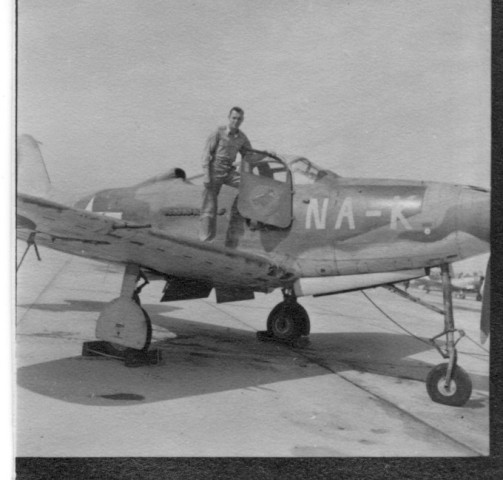
War Story
Born in New York City, Phil Lacey Sr. dropped out of high school to enlist in the Army Air Forces right after Pearl Harbor. He had his pilot’s license before he had his driver’s license or even owned a car.
Trained to fly P-51 Mustangs for reconnaissance in the European theater, he quickly volunteered to fight in the Pacific when the war in Europe ended. The Japanese surrendered as he was on his way to California to be shipped out to the Far East. Phil remained on active status until early 1946 when he moved to Los Angeles. Southern California was quickly becoming a hot bed of customizing. When not tooling around on his 1939 Harley Phil had started to get interested in cars and began sketching what he thought real dream car should look like.
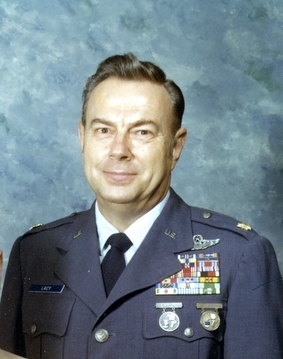
With the Fitzpatrick almost completed Phil was recalled to active duty for the Korean War in July 1951. By the time he got back to the States he had lost contact with the Fitzpatrick and dreams of a career designing the cars of tomorrow in Detroit become a distinguished career in the military.
The next stop was Japan, flying B-57’s (USAF version of the British Canberra) on reconnaissance missions over Russia. In 1967 Phil was stationed in Vietnam, flying B-57’s out of Phanrang with the 8th Tactical Bombardment Squadron. In total Phil flew 260 combat missions with infamous Doom Pussy night fighters, retiring from the air force in 1970.
Joe Who…..The Bortz Collection
Mention any dream car from the fifties and sixties and Joe Bortz has owned it, restored it and probably found it and if not one of those three is currently looking for it.
Joe has amassed a unique collection of dream cars from the golden age of the auto show. These were the shows cars that gave the automotive buying public a taste of what was coming down the pike in a few years or used simply to gage their reaction to styling features found on next years model.
His collection includes such one off show cars as the 53 Buick Wildcat, 54 Pontiac Bonneville, Mercury X-800, 1957 Chrysler Diablo, 64 Dodge Charger and 64 Pontiac Banshee. None of which ever graced the showroom at your local dealer.
It would be more apropos to call Joe by his chosen moniker, vehicular archeologist, as he has not just restored these cars but also unearthed them. Joe rescued and restored four GM Motorama show cars from the legendary Warhoops wrecker’s yard in Detroit. That particular cache included both LaSalle II’s a sedan and roadster, the Chevrolet Biscayne and the 56 Cadillac Brougham town car.







6 Comments
What a beauty .
-Nate
I’m the turd in the punch bowl. That grill and bumper is awful based on a google image search
You have this curvaceous car yet you have a railroad rail with holes in it for a bumper.
Maybe that’s why the images in this story only show the front at an angle.
I hear ya – the face looks like the Hamburger mated with a Flower Horn fish.
For me it’s key to keep in mind when this was made – in that context it really is amazing.
Nice story and well written.
Great story – thank you.
It is interesting how these heroes from the war came back home and invigorated the car industries in so many places. Even true in Germany, Italy, and Jap.., well not so much them.
Here’s a video: